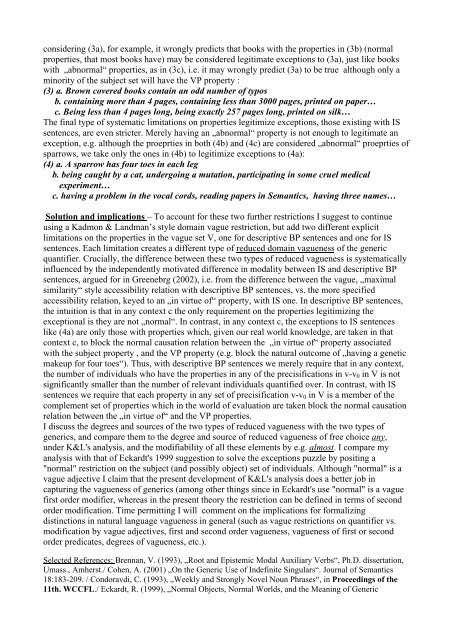SemPrag03.Progr.pdf - Institut für Linguistik/Germanistik - Universität ...
SemPrag03.Progr.pdf - Institut für Linguistik/Germanistik - Universität ...
SemPrag03.Progr.pdf - Institut für Linguistik/Germanistik - Universität ...
Create successful ePaper yourself
Turn your PDF publications into a flip-book with our unique Google optimized e-Paper software.
considering (3a), for example, it wrongly predicts that books with the properties in (3b) (normal<br />
properties, that most books have) may be considered legitimate exceptions to (3a), just like books<br />
with „abnormal“ properties, as in (3c), i.e. it may wrongly predict (3a) to be true although only a<br />
minority of the subject set will have the VP property :<br />
(3) a. Brown covered books contain an odd number of typos<br />
b. containing more than 4 pages, containing less than 3000 pages, printed on paper…<br />
c. Being less than 4 pages long, being exactly 257 pages long, printed on silk…<br />
The final type of systematic limitations on properties legitimize exceptions, those existing with IS<br />
sentences, are even stricter. Merely having an „abnormal“ property is not enough to legitimate an<br />
exception, e.g. although the proeprties in both (4b) and (4c) are considered „abnormal“ proeprties of<br />
sparrows, we take only the ones in (4b) to legitimize exceptions to (4a):<br />
(4) a. A sparrow has four toes in each leg<br />
b. being caught by a cat, undergoing a mutation, participating in some cruel medical<br />
experiment…<br />
c. having a problem in the vocal cords, reading papers in Semantics, having three names…<br />
Solution and implications – To account for these two further restrictions I suggest to continue<br />
using a Kadmon & Landman’s style domain vague restriction, but add two different explicit<br />
limitations on the properties in the vague set V, one for descriptive BP sentences and one for IS<br />
sentences. Each limitation creates a different type of reduced domain vagueness of the generic<br />
quantifier. Crucially, the difference between these two types of reduced vagueness is systematically<br />
influenced by the independently motivated difference in modality between IS and descriptive BP<br />
sentences, argued for in Greenebrg (2002), i.e. from the difference between the vague, „maximal<br />
similarity“ style accessibility relation with descriptive BP sentences, vs. the more specified<br />
accessibility relation, keyed to an „in virtue of“ property, with IS one. In descriptive BP sentences,<br />
the intuition is that in any context c the only requirement on the properties legitimizing the<br />
exceptional is they are not „normal“. In contrast, in any context c, the exceptions to IS sentences<br />
like (4a) are only those with properties which, given our real world knowledge, are taken in that<br />
context c, to block the normal causation relation between the „in virtue of“ property associated<br />
with the subject property , and the VP property (e.g. block the natural outcome of „having a genetic<br />
makeup for four toes“). Thus, with descriptive BP sentences we merely require that in any context,<br />
the number of individuals who have the properties in any of the precisifications in v-v 0 in V is not<br />
significantly smaller than the number of relevant individuals quantified over. In contrast, with IS<br />
sentences we require that each property in any set of precisification v-v 0 in V is a member of the<br />
complement set of properties which in the world of evaluation are taken block the normal causation<br />
relation between the „in virtue of“ and the VP properties.<br />
I discuss the degrees and sources of the two types of reduced vagueness with the two types of<br />
generics, and compare them to the degree and source of reduced vagueness of free choice any,<br />
under K&L's analysis, and the modifiability of all these elements by e.g. almost. I compare my<br />
analysis with that of Eckardt's 1999 suggestion to solve the exceptions puzzle by positing a<br />
"normal" restriction on the subject (and possibly object) set of individuals. Although "normal" is a<br />
vague adjective I claim that the present development of K&L's analysis does a better job in<br />
capturing the vagueness of generics (among other things since in Eckardt's use "normal" is a vague<br />
first order modifier, whereas in the present theory the restriction can be defined in terms of second<br />
order modification. Time permitting I will comment on the implications for formalizing<br />
distinctions in natural language vagueness in general (such as vague restrictions on quantifier vs.<br />
modification by vague adjectives, first and second order vagueness, vagueness of first or second<br />
order predicates, degrees of vagueness, etc.).<br />
Selected References: Brennan, V. (1993), „Root and Epistemic Modal Auxiliary Verbs“, Ph.D. dissertation,<br />
Umass., Amherst./ Cohen, A. (2001) „On the Generic Use of Indefinite Singulars“. Journal of Semantics<br />
18:183-209. / Condoravdi, C. (1993), „Weekly and Strongly Novel Noun Phrases“, in Proceedings of the<br />
11th. WCCFL./ Eckardt, R. (1999), „Normal Objects, Normal Worlds, and the Meaning of Generic

















